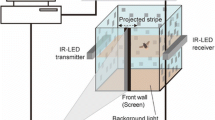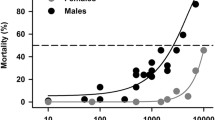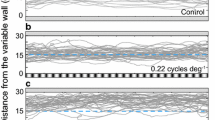Summary
Flies (Musca domestica) avoid danger by initiating a rapid jump followed by flight. To identify the visual cues that trigger the escape response in the housefly, we measured the timing and probability of escapes when the fly was presented with a variety of visual stimuli created by moving targets toward it. Our results show that an escape response is triggered by an approaching dark disk, but not by a receding dark disk. On the other hand, a bright disk elicits escape only when it recedes. A disk with black and white rings is less effective at eliciting escape than is a dark solid disk of the same size. This indicates that the darkening contrast produced by an approaching stimulus is a more crucial parameter than expansion cues contained in the optical flow. Escape is also triggered by a horizontally moving dark edge, but not by a moving bright edge or by a grating. An examination of several visual parameters reveals that the darkening contrast, measured from the onset of stimulation to the start of escape is nearly constant for a variety of stimuli that trigger escape reliably. Thus darkening contrast, coupled with motion may be crucial in eliciting the visually evoked escape response. Other visual parameters such as time-to-contact or target angular velocity seem to be relatively unimportant to the timing of escapes.
Similar content being viewed by others
Abbreviations
- P s :
-
Probability of successful escape
- r disk :
-
radius of disk target
- r arena :
-
radius of shielding arena
- v disk :
-
linear velocity of disk target
- v edge :
-
linear velocity of edge
- d disk :
-
angular velocity of disk target boundary
- ω edge :
-
angular velocity of edge
- ω escape :
-
target distance at escape
- d start :
-
target distance before onset of target movement
- h edge :
-
height of the edge above fly
- x start :
-
distance from corner of triangle to start position of edge (0 or 50 mm)
- x escape :
-
distance from corner of triangle to the position of the edge when the fly escapes
- x center :
-
distance from corner of triangle to point above the center of the pad
- x total :
-
distance from the corner of the triangle to the base (height of triangle = base of triangle)
References
Bacon JB, Strausfeld NJ (1986) The dipteran ‘Giant fibre’ pathway: neurons and signals. J Comp Physiol A 158:529–548
Beersma DGM, Stavenga DG, Kuiper JW (1977) Retinal lattice, visual field and binocularities in flies. J Comp Physiol 119:207–220
Borst A, Bahde S (1986) What kind of movement detector is triggering the landing response of the housefly? Biol Cybern 55:59–69
Borst A, Bahde S (1988) Spatio-temporal integration of motion, a simple strategy for safe landing in flies. Naturwissenschaften 75:265–267
Collett TS, Land MF (1975) Visual control of the flight behaviour in the hoverfly Syritta pipiens L. J Comp Physiol 99:1–66
Dvorak D, Srinivasan MV, French AS (1980) The contrast sensitivity of fly movment-detecting neurons. Vision Res 20:397–407
Fernandez Perez De Talens C, Taddei Ferretti C (1975) Landing and optomotor responses of the fly Musca. In: Horridge GA (ed) The compound eye and vision of insects. Clarendon Press, Oxford, pp 490–501
Glantz RM (1974) Defense reflex and motion detector responsiveness to approaching targets: the motion detector trigger to the defense reflex pathway. J Comp Physiol 95:297–314
Goodman LJ (1960) The landing response of insects I. The landing response of the fly, Lucilia sericata, and other Calliphorinae. J Exp Biol 37:854–878
Hardie RC (1977) Flight initiation in the fly Lucilia. Proc Aust Physiol Pharmacol Soc 8:9
Hardie RC, Franceschini N, Ribi W, Kirschfeld K (1981) Distribution and properties of sex-specific photoreceptors in the fly Musca domestica. J Comp Physiol 145:139–152
Hausen K, Strausfeld NJ (1980) Sexually dimorphic interneuron arrangements in the fly visual system. Proc R Soc Lond B: 208:57–71
Lee DN (1980) The optic flow field: the foundation of vision. Phil Trans R Soc Lond B 290:69–179
Levine J (1974) Giant neuron input in mutant and wild type Drosophila. J Comp Physiol 93:265–285
Levine J, Tracey D (1973) Structure and function of the giant motorneuron of Drosophila melanogaster. J Comp Physiol 87:213–235
Milde JJ, Strausfeld NJ (1990) Cluster organization and response characteristics of the giant fiber pathway of the blowfly Calliphora erythrocephala. J Comp Neurol 294:59–75
Mulloney B (1969) Interneurons in the central nervous system of flies and the start of flight. Z vergl Physiol 64:243–253
Nalbach H-O (1990) Visually elicited escape in crabs. In: Wiese K (ed) Frontiers in crustacean neurobiology. Birkhäuser, Basel, pp 165–172
Power ME (1948) The thoracico-abdominal nervous system of an adult insect, Drosophila melanogaster. J Comp Neurol 88:347–409
Reichardt W (1987) Evaluation of optical motion information by movement detectors. J Comp Physiol A 161:533–547
Wagner H (1982) Flow-field variables trigger landing in flies. Nature 297:147–148
Wyman RJ, Thomas JB, Salkoff L, King DG (1985) The Drosophila giant fiber system. In: Eaton RC (ed) Neural mechanisms of startle behavior. Plenum, New York, pp 133–161
Author information
Authors and Affiliations
Rights and permissions
About this article
Cite this article
Holmqvist, M.H., Srinivasan, M.V. A visually evoked escape response of the housefly. J Comp Physiol A 169, 451–459 (1991). https://doi.org/10.1007/BF00197657
Accepted:
Issue Date:
DOI: https://doi.org/10.1007/BF00197657




